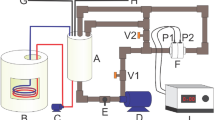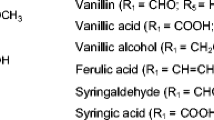Abstract
To reduce phenolic pollutants in the environment, many countries have imposed firm restrictions on industrial wastewater discharge. In addition, the current industrial process of phenolic resin production uses phenol and formaldehyde as the reactants to perform a polycondensation reaction. Due to the toxicity of formaldehyde and phenolic pollutants, the main purpose of this research was to design a green process using horseradish peroxidase (HRP) enzymatic polymerization to remove phenols and to produce formaldehyde-free phenolic polymers. In this study, the optimal reaction conditions, such as reaction temperature, pH, initial phenol concentration and initial ratio of phenol, and H2O2, were examined. Then, the parameters of the enzyme kinetics were determined. To solve the restriction of enzyme inactivation, several nonionic surfactants were selected to improve the phenol removal efficiency, and the optimal operation conditions in a surfactant-containing system were also confirmed. Importantly, the molecular weight of the synthetic phenolic polymers could be controlled by adjusting the ratio of phenol and H2O2. The content of biphenols in the products was almost undetectable. Collectively, a green chemistry process was proposed in this study and would benefit the treatment of phenol-containing wastewater and the production of formaldehyde-free phenolic resin in the future.







Similar content being viewed by others
Abbreviations
- BLC:
-
Bovine liver catalase
- GPC:
-
Gel permeation chromatography
- HPLC:
-
High-performance liquid chromatography
- HRP:
-
Horseradish peroxidase
- IARC:
-
International Agency for Research on Cancer
- KM :
-
Michaelis constant
- Mn:
-
Number average molecular weights
- Mw:
-
Weight average molecular weights
- THF:
-
Tetrahydrofuran
- US EPA:
-
United States Environmental Protection Agency
- V0 :
-
Initial rate
- Vmax :
-
Maximal velocity
References
Wang, W., Yang, K., Sierra, J. M., Zhang, X., Yuan, S., & Hu, Z. (2017). Potential impact of methyl isobutyl ketone (MIBK) on phenols degradation in an UASB reactor and its degradation properties. Journal of Hazardous Materials, 333, 73–79.
Ibrahim, M. S., Ali, H. I., Taylor, K. E., Biswas, N., & Bewtra, J. K. (2001). Enzyme-catalyzed removal of phenol from refinery wastewater: feasibility studies. Water Environment Research, 73(2), 165–172.
Wang, S., Fang, H., Yi, X., Xu, Z., Xie, X., Tang, Q., Ou, M., & Xu, X. (2016). Oxidative removal of phenol by HRP-immobilized beads and its environmental toxicology assessment. Ecotoxicology and Environmental Safety, 130, 234–239.
Jõesaar, M., Viggor, S., Heinaru, E., Naanuri, E., Mehike, M., Leito, I., & Heinaru, A. (2017). Strategy of Pseudomonas pseudoalcaligenes C70 for effective degradation of phenol and salicylate. PLoS One, 12(3), 1–17.
Bayramoğlu, G., & Arica, M. Y. (2008). Enzymatic removal of phenol and p-chlorophenol in enzyme reactor: horseradish peroxidase immobilized on magnetic beads. Journal of Hazardous Materials, 156(1–3), 148–155.
Wu, Y., Taylor, K. E., Biswas, N., & Bewtra, J. K. (1999). Kinetic model for removal of phenol by horseradish peroxidase with PEG. Journal of Environmental Engineering, 125(5), 451–458.
Al-Ansari, M. M., Modaressi, K., Taylor, K. E., Bewtra, J. K., & Biswas, N. (2010). Soybean peroxidase-catalyzed oxidative polymerization of phenols in coal-tar wastewater: comparison of additives. Environmental Engineering Science, 27(11), 967–975.
Ahirwar, R., Jai, S., Singh, B., Kumar, K., Nahar, P., & Kumar, S. (2017). A simple and efficient method for removal of phenolic contaminants in wastewater using covalent immobilized horseradish peroxidase. Journal of Materials Science and Engineering B, 7(1–2), 27–38.
Chagas, P. M. B., Torres, J. A., Silva, M. C., & Correa, A. D. (2015). Immobilized soybean hull peroxidase for the oxidation of phenolic compounds in coffee processing wastewater. International Journal of Biological Macromolecules, 81, 568–575.
Steevensz, A., Madur, S., Feng, W., Taylor, K. E., Bewtra, J. K., & Biswas, N. (2014). Crude soybean hull peroxidase treatment of phenol in synthetic and real wastewater: enzyme economy enhanced by Triton X-100. Enzyme and Microbial Technology, 55, 65–71.
Kim, S. J., Joo, J. C., Song, B. K., Yoo, Y. J., & Kim, Y. H. (2016). Improving the synthesis of phenolic polymer using Coprinus cnereus peroxidase mutant Phe230Ala. Enzyme and Microbial Technology, 87–88, 37–43.
Kim, Y. H., Won, K., Kwon, J. M., Jeong, H. S., Park, S. Y., & An, E. S.,& Song, B. K. (2005). Synthesis of polycardanol from a renewable resource using a fungal peroxidase from Coprinus cinereus. Journal of Molecular Catalysis B: Enzymatic, 34(1–6), 33–38.
Al-Ansari, M. M., Steevensz, A., Al-Aasm, N., Taylor, K. E., Bewtra, J. K., & Biswas, N. (2009). Soybean peroxidase-catalyzed removal of phenylenediamines and benzenediols from water. Enzyme and Microbial Technology, 45(4), 253–260.
Besharati Vineh, B., Saboury, A. A., Poostchi, A. A., Rashidi, A. M., & Parivar, K. (2018). Stability and activity improvement of horseradish peroxidase by covalent immobilization on functionalized reduced graphene oxide and biodegradation of high phenol concentration. International Journal of Biological Macromolecules, 106, 1314–1322.
Lee, M. Y., Bigdelou, P., Hong, K. J., Kim, K. A., Shinya, Y., & Kajiuchi, T. (2018). Peroxidase chemically attached on polymeric micelle and its reaction with phenolic compounds. Enzyme and Microbial Technology, 109, 43–50.
Han, J., Cai, Y., Wang, Y., Gu, L., Li, C., Mao, Y., Zhang, W., & Ni, L. (2019). Synergetic effect of Ni2+ and 5-acrylamidobenzoboroxole functional groups anchoring on magnetic nanoparticles for enhanced immobilization of horseradish peroxidase. Enzyme and Microbial Technology, 120, 136–143.
Bilal, M., Rasheed, T., Zhao, Y., Iqbal, H. M. N., & Cui, J. (2018). “Smart” chemistry and its application in peroxidase immobilization using different support materials. International Journal of Biological Macromolecules, 119, 278–290.
Bilal, M., Rasheed, T., Iqbal, H. M. N., Hu, H., Wang, W., & Zhang, X. (2017). Novel characteristics of horseradish peroxidase immobilized onto the polyvinyl alcohol-alginate beads and its methyl orange degradation potential. International Journal of Biological Macromolecules, 105(Pt 1), 328–335.
Razzaghi, M., Karimi, A., Ansari, Z., & Aghdasinia, H. (2018). Phenol removal by HRP/GOx/ZSM-5 from aqueous solution: artificial neural network simulation and genetic algorithms optimization. Journal of the Taiwan Institute of Chemical Engineers, 89, 1–14.
Ni, Y., Li, J., Huang, Z., He, K., Zhuang, J., & Yang, W. (2013). Improved activity of immobilized horseradish peroxidase on gold nanoparticles in the presence of bovine serum albumin. Journal of Nanoparticle Research, 15(11), 2038.
Hsieh, Y. P., & Lin, S. C. (2015). Effect of PEGylation on the activity and stability of horseradish peroxidase and L-N-carbamoylase in aqueous phases. Process Biochemistry, 50(9), 1372–1378.
Villalobos, D. A., & Buchanan, I. D. (2002). Removal of aqueous phenol by Arthromyces ramosus peroxidase. Journal of Environmental Engineering and Science, 1, 65–73.
Bódalo, A., Gomez, J. L., Gomez, E., Bastida, J., & Maximo, M. F. (2006). Comparison of commercial peroxidases for removing phenol from water solutions. Chemosphere, 63(4), 626–632.
Eker, B., Zagorevski, D., Zhu, G., Linhardt, R. J., & Dordick, J. S. (2009). Enzymatic polymerization of phenols in room-temperature ionic liquids. Journal of Molecular Catalysis B: Enzymatic, 59(1–3), 177–184.
Alemzadeh, I., & Nejati, S. (2009). Phenols removal by immobilized horseradish peroxidase. Journal of Hazardous Materials, 166(2–3), 1082–1086.
Ai, J., Zhang, W., Liao, G., Xia, H., & Wang, D. (2016). Immobilization of horseradish peroxidase enzymes on hydrous-titanium and application for phenol removal. RSC Advances, 6, 38117–38123.
Kalaiarasan, E., & Palvannan, T. (2014). Removal of phenols from acidic environment by horseradish peroxidase (HRP): aqueous thermostabilization of HRP by polysaccharide additives. Journal of the Taiwan Institute of Chemical Engineers, 45(2), 625–634.
Ahmaruzzaman, M. (2008). Adsorption of phenolic compounds on low-cost adsorbents: a review. Advances in Colloid and Interface Science, 143(1–2), 48–67.
Bajpai, S. K., & Sharma, S. (2004). Investigation of swelling/degradation behaviour of alginate beads crosslinked with Ca2+ and Ba2+ ions. Reactive & Functional Polymers, 59(2), 129–140.
Dinh, P. V., & Bach, L. T. (2014). Immobilized bacteria by using PVA (polyvinyl alcohol) crosslinked with sodium sulfate. International Journal of Science and Engineering, 7(1), 41–47.
Zhang, L., Zhang, Y., Xue, Y., Duan, H., & Cui, Y. (2013). Enzymatic synthesis of soluble phenol polymer in water using anionic surfactant as additive. Polymer International, 62(9), 1277–1282.
Sahoo, S. K., Liu, W., Samuelson, L. A., Kumar, J., & Cholli, A. L. (2002). Biocatalytic polymerization of p-cresol: an in-situ NMR approach to understand the coupling mechanism. Macromolecules, 35(27), 9990–9998.
Zhang, L., Zhao, W., Ma, Z., Nie, G., & Cui, Y. (2012). Enzymatic polymerization of phenol catalyzed by horseradish peroxidase in aqueous micelle system. European Polymer Journal, 48(3), 580–585.
Schwartz, R. D., & Hutchinson, D. B. (1981). Microbial and enzymatic production of 4,4′-dihydroxybiphenyl via phenol coupling. Enzyme and Microbial Technology, 3(4), 361–363.
Kimura, Y., Takahashi, A., Kashiwada, A., & Yamada, K. (2016). Removal of bisphenol A and its derivatives from aqueous medium through laccase-catalyzed treatment enhanced by addition of polyethylene glycol. Environmental Technology, 37(14), 1733–1744.
Funding
This work was supported by the Ministry of Science and Technology, Taiwan, Republic of China [MOST 106-2622-8-007-017, MOST 107-2622-8-007-015, and MOST 108-2622-8-007-016].
Author information
Authors and Affiliations
Corresponding author
Ethics declarations
Conflict of Interest
The authors declare that they have no conflict of interest.
Additional information
Publisher’s Note
Springer Nature remains neutral with regard to jurisdictional claims in published maps and institutional affiliations.
Rights and permissions
About this article
Cite this article
Yao, CL., Lin, CC., Chu, IM. et al. Development of a Surfactant-Containing Process to Improve the Removal Efficiency of Phenol and Control the Molecular Weight of Synthetic Phenolic Polymers Using Horseradish Peroxidase in an Aqueous System. Appl Biochem Biotechnol 191, 45–58 (2020). https://doi.org/10.1007/s12010-020-03245-6
Received:
Accepted:
Published:
Issue Date:
DOI: https://doi.org/10.1007/s12010-020-03245-6




